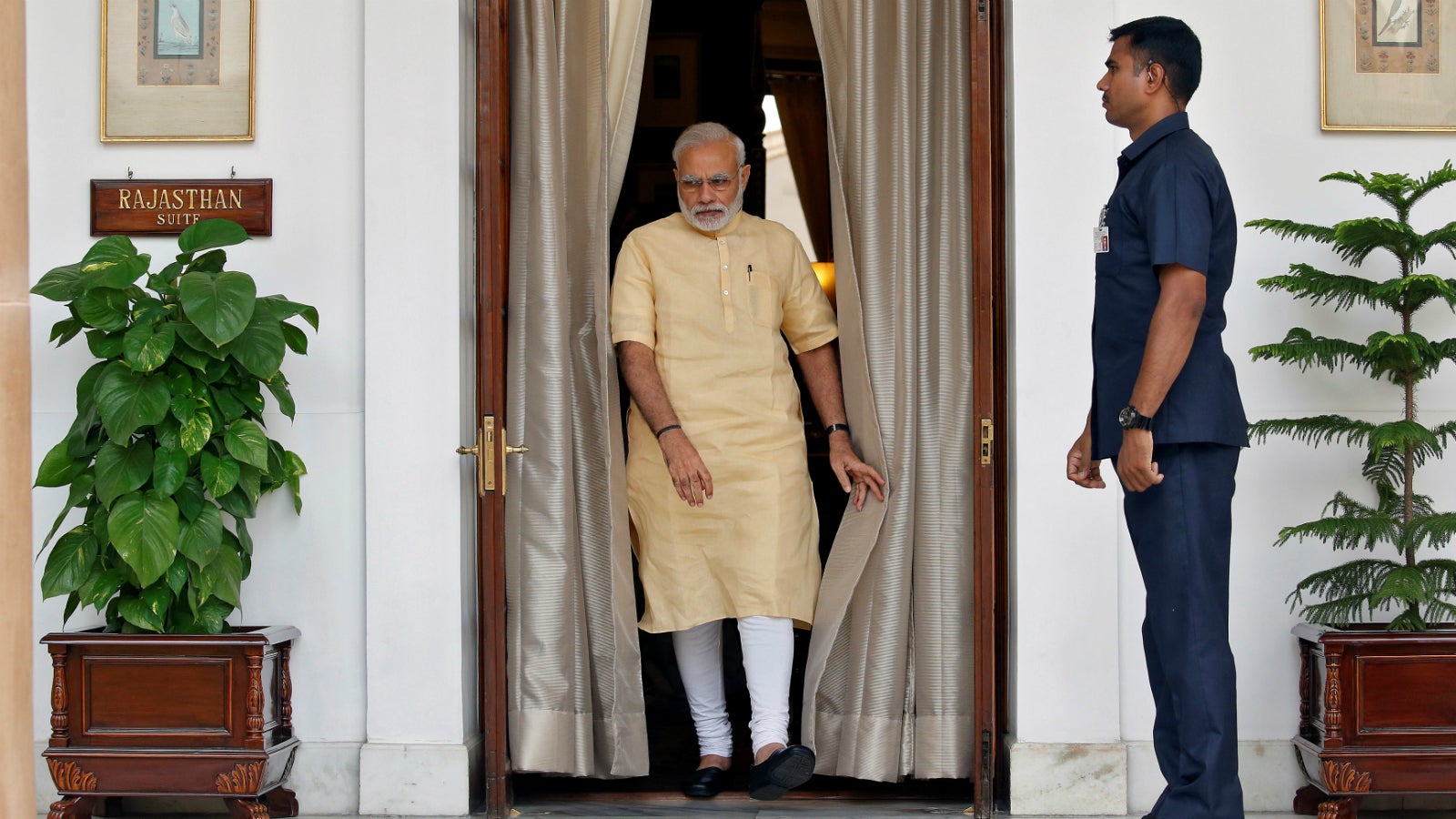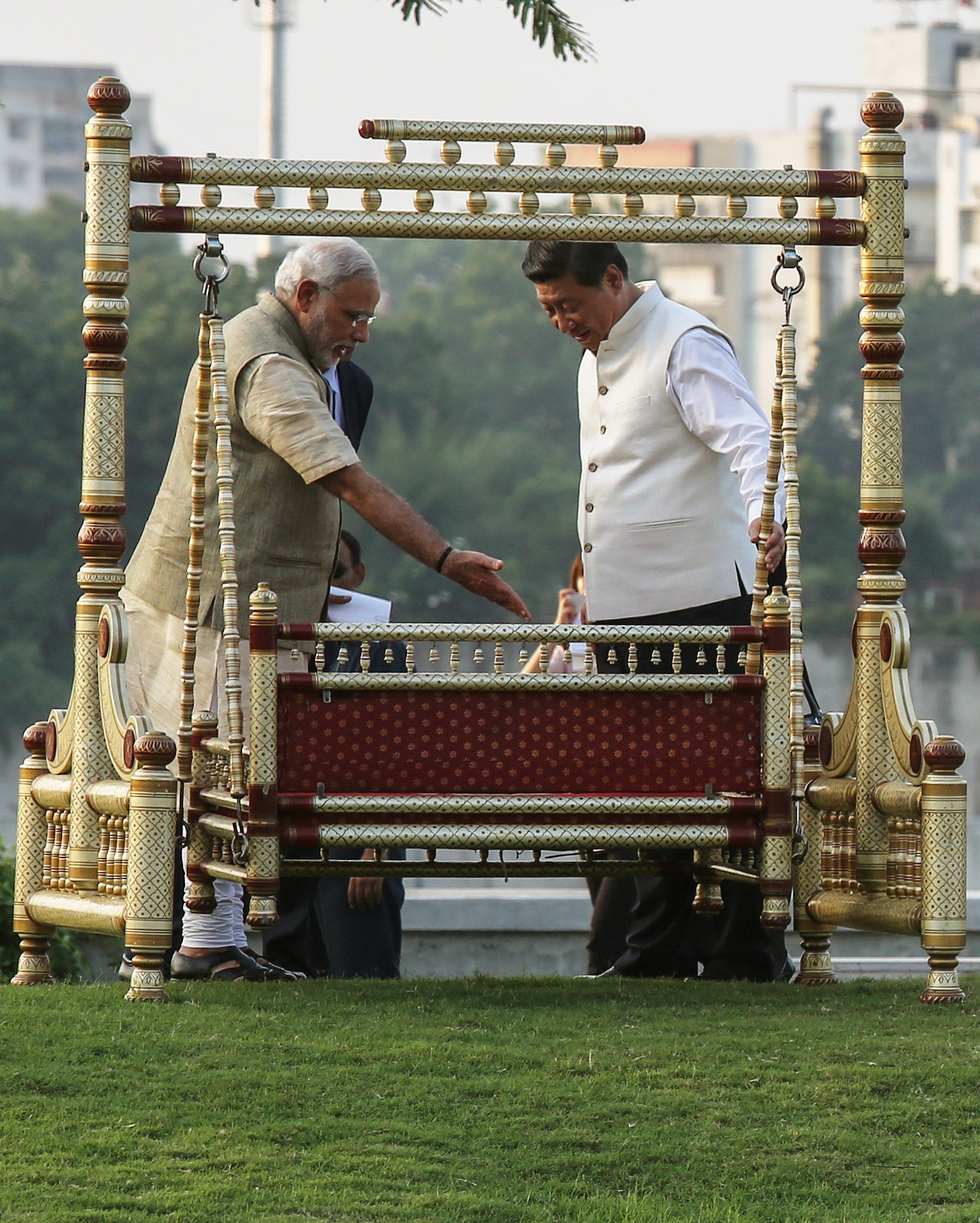Narendra Modi’s big foreign policy win: Selling India like nobody’s business
On May 26, 2014, guests at the forecourt of New Delhi’s Rashtrapati Bhawan witnessed an extraordinary sight. As president Pranab Mukherjee swore in Narendra Modi as India’s 15th prime minister, the leader of almost every South Asian nation—including, notably, Pakistan’s Nawaz Sharif—watched on from the front row.


On May 26, 2014, guests at the forecourt of New Delhi’s Rashtrapati Bhawan witnessed an extraordinary sight. As president Pranab Mukherjee swore in Narendra Modi as India’s 15th prime minister, the leader of almost every South Asian nation—including, notably, Pakistan’s Nawaz Sharif—watched on from the front row.
Four months later, prime minister Modi strolled with Chinese president Xi Jinping along Ahmedabad’s Sabarmati riverfront before the two plonked themselves on an ornate swing, smiling.
The two events, perfectly choreographed, were meant to announce Modi’s arrival on the world stage and a declaration of his intent to spearhead India’s foreign policy.

Three years later, Modi’s bold approach seems to have somewhat misfired. New Delhi’s relationship with Islamabad lies in tatters, its rapport with Nepal is under a cloud, and the bonhomie with Beijing has turned into distinct acrimony. Yet, for all the hard questions raised about his foreign policy achievements, the globe-trotting prime minister’s economic diplomacy is being marked out as a high point.
“He began his foreign policy stint, as it were, in good faith and then suddenly realised that the world is not such a good place out there,” said Rajiv Kumar, an economist and author of the 2016 book, Modi and his Challenges.
“Where I think prime minister Modi has made a very big difference is that he has linked foreign policy directly to India’s economic interests,” Kumar said at an event at Brookings India, a New Delhi-based think-tank.
Winning over the West
Towards the West, Modi has successfully built on the India-US relationship laid by his predecessor Manmohan Singh, starting with his remarkable event centred around the Indian diaspora at New York’s Madison Square Garden in September 2014.
“On the US (front), he has done very well. India has come a long way from its wariness of the US. Earlier governments get some credit, but Modi has re-pivoted India’s foreign policy in just a few years,” said Shailesh Kumar, senior analyst at Eurasia Group, a political risk consultancy.
Although Modi and US president Donald Trump are yet to meet, Kumar expects a push from New Delhi to make “the US economy and defence apparatus prioritise India based upon (a) symbiotic relationship.” Those close to the Modi administration hold a similar view. “…with the US, as everyone is predicting, it will be a more transactional relationship than a kind of a personal bond,” said Vijay Chauthaiwale, foreign affairs in-charge at the Bharatiya Janata Party (BJP).
Overall, India may be deploying a different approach towards its diplomatic outreach. “There is an important foreign policy shift taking place under prime minister Modi. One based on realpolitik where his administration is taking a realist approach towards relations, and working with those who can benefit India,” added Kumar, a former India economist at the US department of treasury.
Modi’s engagement with Europe, too, has been along those lines. In 2015, when German chancellor Angela Merkel came visiting, the two countries signed a $2.25 billion deal for solar and clean energy, a sector that the Modi government has been solidly backing domestically. The Indian prime minister is due to visit Germany later in May and economic matters are expected to remain front and centre, including a free trade agreement with the European Union.
With France, a multi-billion-dollar deal to buy 36 Rafale fighter jets was finally sealed under Modi’s watch in September 2016. The purchase had been hanging fire since 2012, and marked the first big order of fighter jets for the Indian Air Force in some two decades. Weeks later, in November, when Theresa May took off on her first bilateral trip after taking office, she came to New Delhi to try and bolster trade ties.
Eastern promises
Modi’s diplomatic enthusiasm has also been in evidence in the Asia-Pacific. Since taking office, he has travelled to Australia, China, Japan, Laos, Singapore, South Korea, Thailand, Myanmar, Vietnam, and Fiji. “Prime minister Modi has significantly lifted India’s foreign policy strategy towards engaging with Asian economies, and has achieved notable success in strengthening bilateral economic and strategic relations with Japan, a key long-term partner for India,” said Rajiv Biswas, Asia-Pacific chief economist at research firm IHS Markit.
Apart from the perennial bugbear Pakistan, China is the other elephant in India’s anteroom. Despite the frenzy early in his term, especially during Jinping’s visit to India and Modi’s trip to Beijing, the Indian prime minister has been unable to turn around the relationship.
“On China, it’s a bit complicated,” said Kumar. “Engagement does not seem to be doing well, but that is not because of poor policy management but rather (due to) India’s very public concerns with China’s investments in the region. Those issues appear to take priority over all other forms of engagement.”
For instance, Beijing’s One Belt, One Road (OBOR) initiative hasn’t gone down well in New Delhi. There are misgivings about the support extended to Islamabad through the $46 billion China-Pakistan Economic Corridor (CPEC) as part of the OBOR. “…the hyphenation of Pakistan and China vis-a-vis India, that is something we need to very carefully watch,” BJP’s Chauthaiwale said, speaking at Brookings India. “I would definitely see the India-China relations as one of the major challenges in the days and months to come.”
But Modi has fared better in the tricky Middle Eastern region, deftly balancing the ties with the Arab states, Iran, and Israel. He’s made trips to Saudi Arabia, UAE, and Qatar to draw investment, signed off on the $500 million Chabahar port deal in Iran and is now preparing to travel to Israel in July.
Salesman-in-chief
All along, Modi’s diplomatic thrust has been backed by ambitious domestic programmes, particularly “Make in India,” which aims to transform the country into a global manufacturing hub. So, during his travels across the world, the prime minister has rarely missed an opportunity to hawk India as a robust investment destination.
“Where I think India got it right was (in) asking companies that wanted to sell to Indians to also procure, or build in India. At face value, this criteria sounds restrictive and the opposite of free market capitalism that some (incorrectly) expected from Modi as he is not a western style capitalist,” Eurasia Group’s Kumar wrote via email. “But, it has helped boost FDI as companies are willing to build in India to sell in India.”
The numbers are clear. In the 2017 financial year, FDI into India reached a $62 billion, despite a slowdown in global FDI inflows.
Yet, some observers reckon that it is hard to accurately evaluate the effect of Modi’s diplomatic magic on the math. “My general impression is that the net impact of the prime minister’s ‘sales pitch’ for India as an investment destination has been positive, but it is impossible to measure that impact with any degree of certainty, given all the other variables that enter into investors’ calculations,” said Nirvikar Singh, professor of economics at the University of California, Santa Cruz, and former member of the advisory group to the Indian finance minister on G-20 matters.
“Ultimately,” added Singh, “whether India’s policy environment is conducive to economic growth is what will matter.”